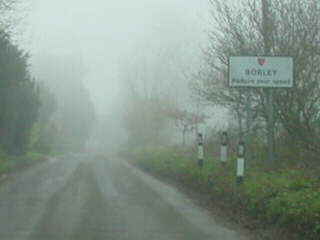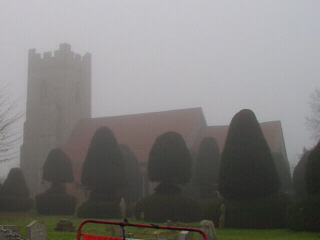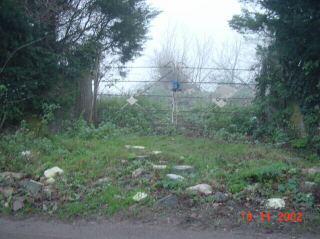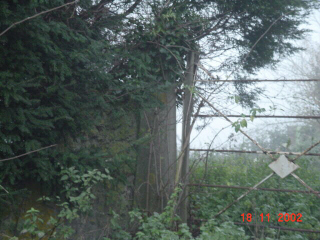
Boundary Sign
My interest in Borley stretches back to 1982 when a chance perusal at an intriguing book title at the local library proved to be rather interesting, to say the least. The title of the book was “The End of Borley Rectory” by Harry Price. Although my finding of the book was more or less by chance, the fact that I was looking at the library section that covers psychic research was anything but by chance! Let me explain!
Around the summer of 1982, a few school friends and myself had, by word of mouth, discovered that very close to our homes stood “Netherby House”, an alleged haunted house of mythical local legend.
Visiting the house revealed clearly that the property was in a state decline and had obviously been unoccupied for sometime. The house was large and rambling with many rooms spaning two floors. The front of the house (although it was actually the side!) had two large bay windows on the ground floor. Entry to the property was made via either the main door (located on the right hand side of the building when looking at the bay windows) or via the door in the glasshouse, which was located on the left-hand side of the building when looking at the bay windows). The kitchen, service areas and servants quarters were at the opposite end to the bay window side (sound familiar?). The house contained cellars under parts of the main living areas complete with storage racks etc and was constructed almost in its entirety using grey Scottish granite and not red clay bricks!
Without going into too much detail of the many visits, we proceeded to deliver several seances (using both the Ouija board and planchette techniques) in one of the rooms of the ground floor. Now to be honest, at this stage I was a bit of a sceptic or non-believer and was only in attendance for a bit of fun. During the various sessions I was convinced that the pointer was being purposely pushed by a member of the party in order to “scare” the rest of us. However, on one occasion we interacted with a would be spirit claiming to be a past resident, who gave her name and told us that she and her sister had lived here between ____ and ____. She also claimed to have died in the place.
Sometime during the follow weeks, while searching the upstairs of the house, a pile of old newspapers was discovered, covered in dust I may add. Intrigued as to their age, we proceed to rifle through them. About halfway through the pile I found a small calling card, clearly very old. On the small white card above the postal address was printed to Gothic type lettering:
The names matched those given by the spirit during the seance! (Note: I have purposely omitted the name given by the spirit, that of the alleged sister and other details/dates for obvious reasons).
Following this startling discovery, we undertook a small investigation to prove the story and after several trips to the newspaper archives at the local library unearthed facts that detailed the untimely death of a young woman at that very house and in the manner described by the spirit! I can say with absolute certainty that there is no possibility that anyone in attendance at the seance could have known these facts nor could the calling card have been from a modern era. It was during this trip to the resource library that I happened upon Harry Price’s “The End of Borley Rectory” and I have taken an active interest in the subject of Borley Rectory and psychic phenomena in general ever since.
Recent publications have stated that the village of Borley is difficult to find and quite rightly so. Although it is clearly listed on maps of the area, there are no signposts and it is near impossible to get directions from locals. The reason for this is no doubt clear to most of us, however any true Borley enthusiast will have little trouble getting there!
My first stop on this occasion was the Bull Hotel in Long Melford for some lunch. The Bull is mentioned a number times in various publications on Borley, the most significant being Harry Price’s “The Most House in England”. According to the current barmaid, the old part of the Bull remains more or less, as it would have been in Price’s era. Sitting by the big open fire with the exposed wooden beams overhead you can almost visualise Messrs Price, Glanville and Co. quaffing pints of ale while pouring over the latest discovers from the Rectory some 65 years previous. This is a must for any visit to the area!
On to Borley! On my approach, the village of Borley was shrouded with fog, adding to the excitement! The first clear indication that the site is close is the village boundary sign.


Over the road, the site of the old Rectory is disappointing. The bungalows that now occupy the site are mostly shrouded from view and I definitely did not feel that it was appropriate to dwell too long gazing on what might have been. It is very disorientating and difficult to gauge the position the rectory would have taken had it still stood. A point that is raised in many publications on the subject is that the Rectory was an ugly red brick monstrosity. However, driving along the tights windy roads leading to Sudbury and Long Melford, the Rectory’s architectural style of red brick and gables is clearly visible on many properties. None more so than the stable cottage at Borley. Given that it is now a private resident, I refrained from photographing the building. The point though is why is the Rectory continually described as a monstrosity when a) it was rather attractive in comparison and b) there are countless other properties in the area displaying the same architecture? One of the bungalows has a “For Sale” sign outside, embossed with a “Sold” sign. I wonder if the new owners are aware of the history surround the land the bungalow sits on!
The most interesting point (but perhaps trivial to some) I noted during this trip is the garden entry posts that are located adjacent to where the small summer at the foot of the Rectory Gardens would have once stood. These are mentioned in at least two publications that I am aware of (Ivan Banks “The Enigma of Borley Rectory” and the summary on Borley in Peter Underwood’s “A-Z of British Ghosts”) they are strangely not mentioned, to my knowledge anyway, in either of Harry Price’s Borley books. I find this bizarre given the detail than Price, Glanville and Co went to detail the house and gardens. Any information to the contrary would be appreciated. Ivan Banks has rightly described the entry gates themselves as being from a modern era however the stone posts are, just possibly, the only remaining structures that once formed part of Borley Rectory and its grounds. I would be fascinated to discover whether in fact this is true. Any information relating to the existence of these stone posts when the Rectory stood would be appreciated. Again, I know this may be trivial in some eyes but definitely not mine!
 Garden Entry |
 Stone Post Close-Up |
I did venture around the other side of the garden (opposite the gates) basically where the Rectory stonewall would have ended and peered into the garden. I can say with sheer delight that it is exactly as I have picture the Rectory Garden to look like. No doubt it has been dug and re-dug over the years however I doubt that it varies much in layout now than it did in 1939, given Price’s plan of the grounds.
I must say disappointingly, I have never experienced any kind of psychic phenomena at Borley during any of my visits however the mystic of the area has been almost overwhelming on each occasion. One thing however did occur this visit that was a little concerning considering that I am, admittedly, very superstitious. Given the foggy conditions, I approached Borley very slowly, and when I arrived at the eastern extend of what would have been the Rectory garden, a Black Cat sat firmly in the middle of road, moving only when I stopped just in front. I motored on up the road and stopped by the church to take a photograph. Again there was the same (?) Black Cat sitting in the Church grounds. I drove further up past the magnificent Borley Place, turned my car, again drove slowly past the church breathing in the atmosphere but had to screech to a halt to avoid……… the Black Cat! Finally, as described above, I chose to have a look at the area that would have housed the small summer house in the Rectory grounds, peering over the wild shrubbery to get a better look, there in the middle of the garden sat a Black Cat. Now I am not saying that there was anything even remotely connecting these incidents to the Rectory story however I am prepared to admit that the final sighting spooked me considerably and I left the area immediately!